CRUFFLER.COM
presents
Firearms
Technical Trivia, August 2000:
There are a handful
of engineers and designers who lived and worked in the latter half of the
19th century and the first quarter of the 20th whose influence is still
keenly felt in the firearms community today. Indeed, it is not inaccurate
to say that the design of every successful firearm since that time is nothing
more than an adaptation of principles developed by these men. Tremendous
debts are owed to men with names like Browning, Nickl, Mauser, Walther,
Wesson, Mannlicher, and Lee. In this intermittent series, CRUFFLER.COM
hopes to provide a historical overview of the highlights of each man's
work. It is not intended to provide an encyclopedic reference, but rather
an introduction that will whet the appetite of burgeoning firearms historians.
Ferdinand,
Ritter von Mannlicher was an Austrian patriot. He was also a first
rate mechanical genius to whom we owe many of the features and design elements
found in both modern firearms and those which are prized by the Cruffler.
He devoted his prodigious talents totally to the production of military
weaponry. It was with this superior weaponry that he hoped to fortify
the Dual Monarchy (the Austro-Hungarian empire) against what he believed
to be an inevitable Russian assault. When he died in 1903, he left
behind an enormous body of work in the firearms field, the breadth of which
has never been equaled. This month's technical trivia will focus
on a brief technical chronology of Mannlicher's career which will highlight
this gifted and prolific designer's work and place it in the proper historical
context.
Mannlicher
did all of his work in latter quarter of the 19th Century. Because
of this, he was necessarily breaking new ground. His work was perforce
original; Mannlicher had no choice but to act in the role of pathfinder
in the field of automatic weapons, repeating rifles, and magazine systems.
In the course of his career, he developed more than 150 models of repeating
and automatic firearms. Indeed, every phase of every system that
has, since that time, been successful (with the exception of the idiosyncratically
American pump and lever actions) may be found within Mannlicher's
body of work.
Most commonly,
the name Mannlicher brings to mind the clip loading system for which he
is justifiably famed. Indeed, it was the first successful multiple
loading system which permitted a rifleman to load a magazine with a single
movement. In the Mannlicher clip system, cartridges are held in a
spring steel clip. The cartridges and clip are inserted into the
magazine as a unit. When the last cartridge is loaded into the chamber,
the clip is ejected from the firearm.
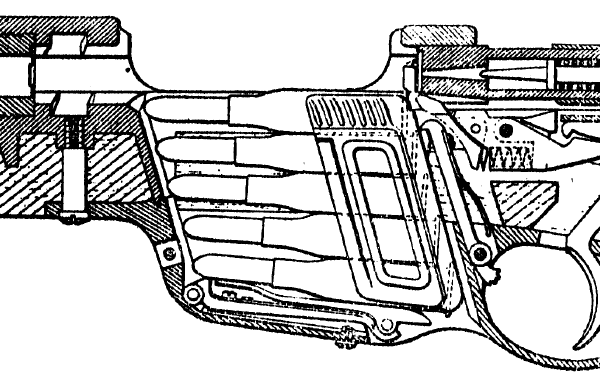
Mannlicher Style Clip as Used in the Mannlicher
M1895 Straight Pull Rifle
Image Credit: Smith,
Walter H.B., Mannlicher Rifles and Pistols, The Military Service
Publishing Company, Harrisburg, Pennsylvania, 1947, Page 121
|
While initially
popular, by the end of the First World War, the system was supplanted in
the bolt action rifle world by the Mauser type clip in which the cartridges
are swept out of the clip and into the magazine.
The Mannlicher
clip system proved much more long-lived in the self-loading rifle field,
being used in the first line rifle of a major power until 1957. Specifically,
the clip used in the M1 (Garand) rifle is but a small modification of the
original Mannlicher design. Unlike most of the familiar Mannlicher
actions, the Garand's clip is ejected from the top of the action when empty.
This technique is not, as may first be assumed, a departure from Mannlicher
designs. The clip in the Austrian M1885 rifle (a Mannlicher design)
was ejected upwards, much like the Garand.
Returning to
the chronology of Mannlicher's career, in 1880, Mannlicher brought out
a turning bolt system, which he later improved upon. As an aside,
the Mannlicher turnbolt actions are almost as simple as the Mauser and
are significantly easier and less expensive to manufacture. The year
1884 found Mannlicher producing the first of his straight pull, revolving
bolt-head magazine rifles for which he later received well deserved acclaim.
From his original designs stemmed all later straight pull actions with
revolving bolt-heads - the Canadian Ross, the Swiss Schmidt-Rubin, and
the modern Mauser M96 (not to mention the later Mannlicher Model 1895).
By 1887, Mannlicher had perfected and unveiled his revolving magazine.
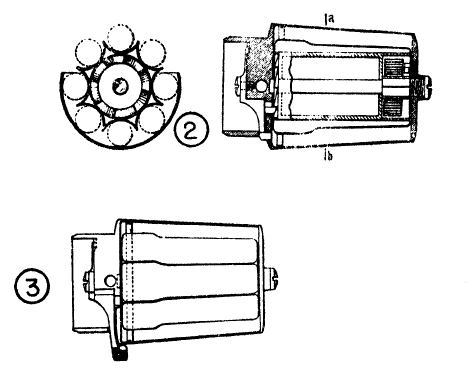
|
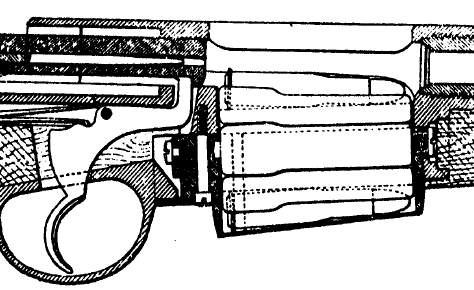
|
Mannlicher
Rotary Magazine. Right hand view shows magazines as mounted in rifle,
left hand view shows magazine from rear (2), top looking down (3), and
right side view (unnumbered).
Image Credit: Smith,
Walter H.B., Mannlicher Rifles and Pistols, The Military Service
Publishing Company, Harrisburg, Pennsylvania, 1947, Page 51
This magazine,
which is still in use today by a number of sporting rifle makers, holds
the cartridges in a spring-loaded revolving spool. Each cartridge
is separated from the others by the construction of the spool, and is thus
protected.
Back tracking
to 1885, we see Mannlicher introducing his first automatic weapon, a light
machinegun. The design of this arm is seminal - while it has been
given very little attention by gun writers, it contained many of the basic
principles that would be widely exploited by later designers. In
any event, the light machinegun unveiled by Mannlicher in 1885 was not
successful; it was simply too far ahead
| of
its time. The military was not psychologically ready for it, and
the state of metallurgy was not advanced enough to provide the necessary
steels for the weapon itself, nor the correct form of brass for the cartridge
cases needed to ensure the gun's reliability. A comparison of the Mannlicher's
operating principles with those of the Browning designs used in the Second
World War provides ample evidence of Mannlicher's foresight and brilliance: |
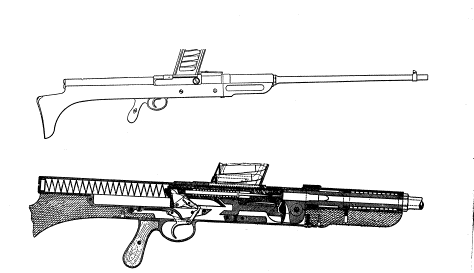
Mannlicher M1885 Light
Machinegun
Image Credit: Smith,
Walter H.B., Mannlicher Rifles and Pistols, The Military Service
Publishing Company, Harrisburg, Pennsylvania, 1947, Page 156
|
-
Both used a short
recoil operating system where the barrel and bolt are locked together and
move rearward together until the bullet has exited the muzzle and chamber
pressure has dropped to a safe level. Then the barrel stops and the
bolt continues to the rear, where it extracts and ejects the fired case,
and then moves forward to reload the arm.
-
Both the Browning
and the Mannlicher designs employ accelerators. When the barrel comes
to a stop, the accelerator is struck sharply, and transfers the force of
this blow to the bolt, accelerating its rearward motion and aiding in proper
function.
-
The basic locking
systems are similar. While the locking systems differ substantially
in shape and the way they are mounted, they are both locked by means of
a wedge cammed up and down from below into a recess cut into the underside
of the bolt, the wedge resting on an abutment in the floor of the receiver
when locked.
-
Both guns share
the same cocking principles. In each gun a pivoted finger lever has
one end passing through a cut in the bolt into engagement with the striker
pin acting to cock the mechanism by leverage during recoil.
-
In both guns the
recoil springs are mounted in the receiver to the rear of the bolt.
While the gun
bears many operating similarities to the Browning, there are other designs
that benefited from Mannlicher's 1885 ideas. The top mounted magazine,
found in British, Czech, and Japanese designs dates back to Mannlicher's
1885 gun.
In 1891 Mannlicher
unveiled a clip loading semiautomatic rifle based on the principles established
in his 1885 machinegun. This rifle used a barrel sleeve like the
one later used by John Browning in the design of his Remington autoloading
rifle (although the resemblance ends there - the Mannlicher was a short
recoil action design, the Browning/Remington a long recoil action design).
Mannlicher's next self loading rifle was brought out in 1893. This
was based on a turning bolt action with locking lugs and locking
surfaces machined on a slight curve designed to delay the opening of the
breech during a period of high pressure. This principle, later found
in the Thompson Rifle which was one of the Garand's competitors, was the
forerunner of the Blish principle, a subject of engineering controversy
for some time.
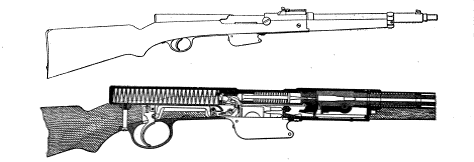
|
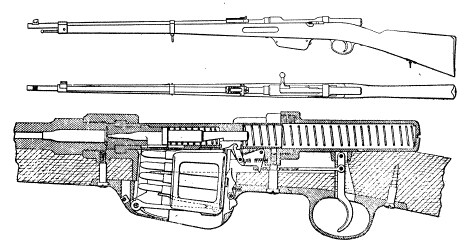
|
Mannlicher
M1891 Self Loading Rifle (Left) and M1893 Self Loading Rifle (Right)
Image Credit: Smith,
Walter H.B., Mannlicher Rifles and Pistols, The Military Service
Publishing Company, Harrisburg, Pennsylvania, 1947, Page 165 and 171
In 1895, military
mindset and metallurgy yet again prevented the adoption of a Mannlicher
design which was substantially ahead of its time. This was a self
loading rifle with so many similarities to the M1 Garand rifle that it
is worthy of special consideration. When comparing basic operating
principles, we see:
-
Both rifles were
gas operated, with barrels ported to allow gas to escape into a gas cylinder
as the bullet passes the port.
-
In each gun, the
gas piston is hollowed out to provide a housing and bearing surface for
the recoil spring, the operating rod is a specially bent extension of the
piston designed to permit the straight rearward thrust of the piston to
be delivered around a corner to work the action. In both Garand and
Mannlicher designs the operating handle is a part of the bent rod such
that pulling it to the rear both cocks the hammer and opens the action
for loading.
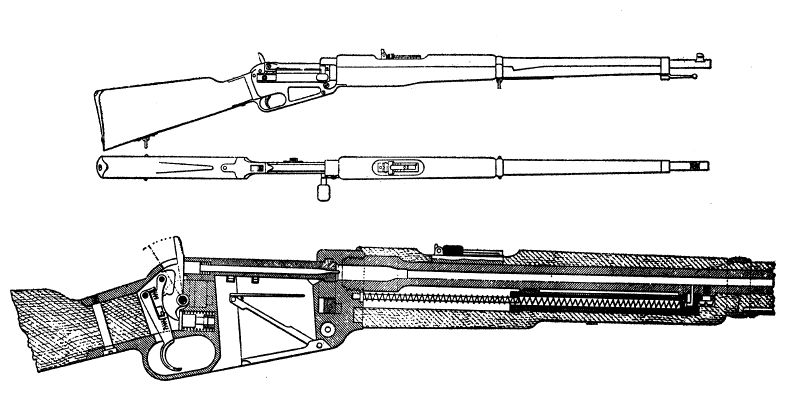
|
Mannlicher
M1895 Self Loading Rifle
Image Credit: Smith,
Walter H.B., Mannlicher Rifles and Pistols, The Military Service
Publishing Company, Harrisburg, Pennsylvania, 1947, Page 198
-
The Mannlicher
and Garand share a common method of unlocking. A cam face on the
operating rod rotates the breechblock to unlock the lugs from their recesses
in the receiver. In the Garand, the bolt is then carried back to
ride over and cock the receiver, and in the Mannlicher the bolt is turned
over to the left on hinges, the rear cam face cocking the hammer.
-
Both load through
the top with a clip that forms part of the magazine itself, both have coil
mainsprings working through plungers.
Even as he neared
the time of his death, the gifted Austrian designer continued to work and
develop, and to manufacture, a great number of firearms whose principles
would not be fully exploited for another forty years. Another example
of his prescient genius was to be found in the short-stroke gas operated
automatic rifle of 1900, the operating principles of which resemble nothing
so much as the US M1 and M2 carbines:
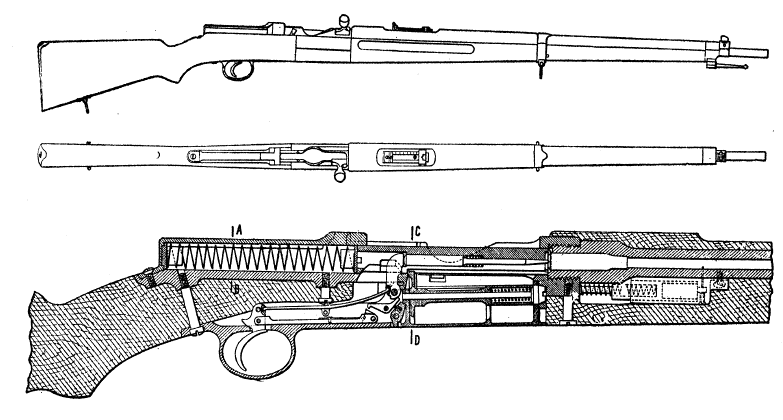
|
Mannlicher
M1900 Self Loading Rifle
Image Credit: Smith,
Walter H.B., Mannlicher Rifles and Pistols, The Military Service
Publishing Company, Harrisburg, Pennsylvania, 1947, Page 234
-
In both systems,
the gas port is placed much closer to the breech than the muzzle.
-
In both, the gas
pistons provide motive and turning power to revolve and unlock the bolt,
and then to drive it back unaccompanied by the piston. Interestingly,
these two points represent the key differences between the US M1 rifle
and M1 carbine.
As can be seen,
the scope and variety of Mannlicher's genius is staggering. While
most Americans think of Ferdinand, Ritter von Mannlicher as little more
than a name, his influence extends deep into firearms technology and culture
in the United States. Moreover, we know that he was a sincere and
honest man whose labors in his chosen field, the field of firearms development,
were gargantuan, and devoted almost entirely to the safety and security
of his native land. There is, perhaps, little more that we can ask
of anyone.
Note:
Data for this month's trivia page was gathered from:
Mannlicher
Rifles and Pistols,
by Walter H.B. Smith, The Military Service Publishing Company, Harrisburg,
Pennsylvania, 1947
Note - this
is an old and out of print volume. Check with your internet or local
rare/used bookseller to inquire about obtaining a copy.
HOME













